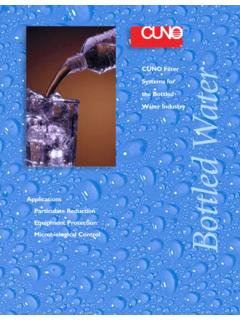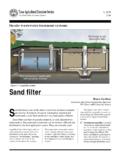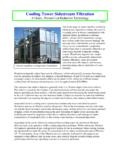Transcription of An Introduction To Slow Sand Filtration - Solutions for Water
1 An Introduction To slow sand Issue 1 December 2005 Filtration 2 Contents 1. Types Of sand filter .. 3 slow sand 3 Rapid sand 4 Roughing 4 The Basic Design Of slow sand Filters .. 5 2. Filtration Mechanism In slow sand Filters .. 6 Physical And Mechanical Processes .. 6 Biological Action .. 6 Algae .. 8 3. sand .. 9 Characterising sand Samples .. 9 Sieve analysis .. 9 sand Requirements .. 11 Washing 12 4. Hydraulics Of Filtration .. 13 5. Basic 15 The Stages In A slow sand Filtration System .. 15 Some Design Notes .. 15 filter Sizing .. 18 Examples Of Basic Designs.
2 18 6. Operation And 21 Commissioning A New 21 filter Cleaning .. 21 7. Roughing Filters .. 22 8. Household sand Filtration .. 24 Appendix A1. Micro-Organisms That Cause Waterborne 26 Appendix A2. RedR Operational 28 Appendix A3. Further Reading & Links .. 29 Types Of sand filter 3 1. Types Of sand filter The use of sand and gravel as filter media for Water supplies can me split into three basic filter types: slow sand filters, rapid filters and roughing filters. Apart from desalination and reverse osmosis, slow sand filters are perhaps the most effective single treatment for purifying drinking Water supplies.
3 They are use on a large scale as part of the Water supply for large cities, as part of systems for small villages and on a much smaller scale they can be adapted for use in individual households. Rapid sand filters are normally require a subsequent chlorination process and are thus of less use for small village supplies unless the raw (untreated) Water supply is of a reliably high quality. Roughing filters are used to reduce the turbidity of Water supplied and often used as a pre-treatment before slow sand Filtration . The important features of these three filter types are detailed below and summarised in table sand Filters slow sand filters use sand with effective sizes of - mm (see section 3) to remove a large percentage of coliforms, cryptospridum and Giardia cysts.
4 They operate most effectively at a flow rate of m/h (or m3/h/m2), which equates to 100 300 l/h per m2 of filter area. These filters use physical processes such as sedimentation, adsorption and straining to remove fine particles as well as microbiological processes to remove organic material and bacteria. Because of the slow filter rates the raw Water sits above the sand for several hours before passing through it, various oxidation reactions break down organic material during this time. Algae, that grows on the sand surface, consumes this oxidised organic material and releases oxygen back into the Water .
5 Roughing filters and sedimentation are often used as pre-treatments to reduce the turbidity of the raw Water and therefore reduce the rate at which the slow sand filter becomes clogged. Some aeration, to increase the oxygen content of the raw Water , is also desirable. Post-f iltration chlorination or UV-purification can also be used; however, with a filter that is functioning well such treatments are not strictly necessary. The flow of raw Water through the filter should be continuous, however small scale filters, for use in individual households, have been designed to work intermittently ( a few hours a day).
6 These have been widely used in several countries around the world (see section 8). Types Of sand filter 4 sand Filters These filters use coarser sand than slow sand filters and the effective size of the filter media is usually greater than mm. The flow rates are normally between 4 and 21 m/h equating to 400 to 2100 l/h per m2 of filter . These filters do not remove disease causing entities as efficiently as slow sand filters and usually need a post Filtration chlorination process. Flocculation and coagulation are sometimes used as pre-treatments. Filters These filters are used to remove suspended solids by passing the Water through material that is much coarser than that used in slow sand Filtration or rapid sand filters.
7 The filter material is usually graded so that the Water passes through coarse (25 mm), medium and then fine (5 mm) sand . Flow rates are often in the region of m/h ( 300 600 l/h per m2 of filter surface area). Rapid sand Filtration slow sand Filtration Improvement of Water quality With pre-treated Water , filtrate quality is possible that has 1 NTU turbidity, 90 % removal of coliforms, 50-90 % removal of cryptosporidium and Giardia cysts, 10 % removal of colour, 5 % removal of total organic content. With raw Water a filtrate quality is possible that has less than 1 NTU turbidity, 95 % removal of coliforms, 99 % removal of cryptosporidium and Giardia cysts, 75 % removal of colour, 10 % removal of total organic content.
8 Flow Rate 4-21 m/h m/h Filtration Medium Graded sand and sometimes additional coarse layers. Effective size > mm and uniformity coefficient < Effective size between mm, uniformity coefficient between 3, preferably < 2. Cleaning Required Backwashing needed frequently Top 1 cm of sand removed every few months. Pre-Treatment Usually necessary including coagulation and flocculation followed by sedimentation. Plain sedimentation and roughing filters may be used to reduce the turbidity to below 20 NTU and preferabley below 5 NTU. Flocculation should not be used. Post- Treatment Chlorination is usually required.
9 Chlorination to be on the safe side. Filtering Mechanism Sedimentation, adsorption , straining, chemical and microbiological processes. Sedimentation, adsorption , straining, chemical and microbiological processes. Main Filtering Mechanism Physical especially adsorption. Microbacterial. Principal Advantages Substantially reduces pathogenic bacteria, viruses and cysts, to produce a potable Water without further treatment. No machinery required. Relatively small and compact. Principle Disadvantages Can only effectively treat low turbidity Water . Cannot produce a potable Water without further treatment. Backwashing Water required to clean filter this usually unvolves pumps.
10 Table : A comparison of slow sand filters and rapid sand filters. Types Of sand filter 5 Basic Design Of slow sand Filters Figure show the basic design principles used in a slow sand filter . Figure : The basic design of a slow sand filter . There are several important elements that should be observed when constructing slow sand filters: The raw Water supply feeding the filter should be able to maintain a constant head of Water above the filter bed, thus there will be a constant pressure pushing Water through the filter1. The raw Water source must therefore be able to supply a flow rate greater than the flow rate through the filter The filter bed (normally sand ) should be at least m deep and should contain sand of an appropriate size and size distribution.







